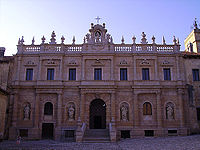- Certosa di Padula
-
Cilento and Vallo di Diano National Park with the Archaeological sites of Paestum and Velia, and the Certosa di Padula * UNESCO World Heritage Site
Country Italy Type Cultural Criteria iii, iv Reference 842 Region ** Europe and North America Inscription history Inscription 1998 (22nd Session) * Name as inscribed on World Heritage List
** Region as classified by UNESCOPadula Charterhouse, in Italian Certosa di Padula (or Certosa di San Lorenzo di Padula), is a large Carthusian monastery, or charterhouse, located in the town of Padula, in the Cilento National Park (near Salerno) in Southern Italy. It is a World Heritage site.
The monastery is the second largest charterhouse in Italy after the one in Parma. Its building history covers 450 years, but the principal parts of the buildings are in Baroque style. It is a very large monastery, comprising 51,500 m² (12.7 acres), with 320 rooms and halls.
History
Padula Charterhouse was founded by Tommaso di San Severino on 27 April 1306 on the site of an earlier monastery. It is dedicated to Saint Lawrence, and its architectural structure supposedly recalls the griddle-iron upon which the saint was burnt alive.
The monastery has the biggest cloister in the world, covering 12,000 m² (2.97 acres) and surrounded by 84 columns. A famous spiral staircase of white marble inside an annex leads to the large library.
According to the strict Carthusian distinction between contemplation and work, there are two distinct places for these practices: on the one hand the peaceful cloisters, the library with its fine Vietri ceramic tiled floor, the chapels decorated with fine inlaid marble works. The altar frontals in most of the chapels are inlaid, not with marble, but with some of the most spectacular 18th. century scagliola work ever created in the 18th. Century.This is the highest concentration of such work in one place. One of the centres of production was in Naples. the cloister orchards; and on the other hand the large kitchen,[1] the cellars with their enormous wine vats, the laundries, and the huge external yards, where there were people working in the stables, ovens, stores, and at the olive oil mill. The yards were used for productive activities and for trade between the charterhouse and the external world.
The monastery also houses the archaeological museum of Western Lucania, which preserves a collection of all the finds unearthed in the excavations at the necropolis of Sala Consilina and Padula. This museum represents a period of time ranging from protohistory to the Hellenistic Age.
References
External links
Coordinates: 40°20′14″N 15°39′07″E / 40.33722°N 15.65194°E

This article about a Christian monastery, abbey, priory or other religious house is a stub. You can help Wikipedia by expanding it.





